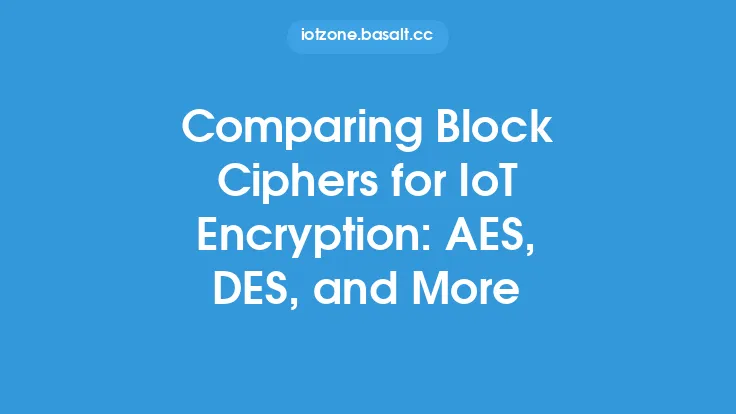When it comes to securing the Internet of Things (IoT), encryption plays a crucial role in protecting the confidentiality, integrity, and authenticity of data transmitted between devices. Two fundamental types of encryption methods are symmetric and asymmetric encryption, each with its strengths and weaknesses. In the context of IoT, understanding the differences between symmetric and asymmetric encryption is essential to determine which approach is best suited for securing IoT communications.
Symmetric Encryption
Symmetric encryption, also known as secret-key encryption, uses the same secret key for both encryption and decryption. This means that the sender and receiver must share the same secret key to encrypt and decrypt the data. Symmetric encryption algorithms, such as Advanced Encryption Standard (AES), are generally faster and more efficient than asymmetric encryption algorithms. They are also less computationally intensive, which makes them suitable for devices with limited processing power, such as many IoT devices. However, symmetric encryption has some limitations. Since the same key is used for both encryption and decryption, it can be vulnerable to key exchange attacks, where an attacker intercepts the shared key. Additionally, symmetric encryption does not provide authentication or non-repudiation, which can make it difficult to verify the identity of the sender and ensure that the data has not been tampered with.
Asymmetric Encryption
Asymmetric encryption, also known as public-key encryption, uses a pair of keys: a public key for encryption and a private key for decryption. This approach allows for secure key exchange and authentication, as the public key can be shared openly without compromising the security of the private key. Asymmetric encryption algorithms, such as RSA and elliptic curve cryptography (ECC), provide a higher level of security than symmetric encryption, as they are more resistant to attacks and can provide authentication and non-repudiation. However, asymmetric encryption is generally slower and more computationally intensive than symmetric encryption, which can be a limitation for devices with limited processing power. Additionally, asymmetric encryption requires more bandwidth and storage, as the public and private keys must be stored and transmitted.
Comparison of Symmetric and Asymmetric Encryption for IoT
When it comes to IoT, the choice between symmetric and asymmetric encryption depends on the specific use case and requirements. Symmetric encryption is generally suitable for applications where data is transmitted between devices that have a pre-established trust relationship, such as in a smart home network. In these cases, the shared secret key can be securely exchanged and stored, and the faster encryption and decryption times can provide better performance. On the other hand, asymmetric encryption is more suitable for applications where devices need to communicate with each other without a pre-established trust relationship, such as in a public IoT network. In these cases, the secure key exchange and authentication provided by asymmetric encryption can ensure the confidentiality, integrity, and authenticity of the data.
Hybrid Approach
In many cases, a hybrid approach that combines symmetric and asymmetric encryption can provide the best of both worlds. For example, asymmetric encryption can be used to securely exchange a shared secret key, which can then be used for symmetric encryption. This approach can provide the security benefits of asymmetric encryption, while also taking advantage of the faster encryption and decryption times of symmetric encryption. In IoT, this hybrid approach can be particularly useful, as it can provide a secure and efficient way to transmit data between devices.
Key Management
Regardless of whether symmetric or asymmetric encryption is used, key management is a critical aspect of IoT security. Key management refers to the process of generating, distributing, storing, and revoking cryptographic keys. In IoT, key management can be particularly challenging, as devices may have limited processing power, memory, and connectivity. Therefore, it is essential to implement a secure and efficient key management system that can handle the unique requirements of IoT devices. This can include using techniques such as key aggregation, where a single key is used to encrypt multiple devices, or key derivation, where a new key is derived from a master key.
Conclusion
In conclusion, both symmetric and asymmetric encryption have their strengths and weaknesses, and the choice of which to use in IoT depends on the specific use case and requirements. Symmetric encryption is generally faster and more efficient, but may be vulnerable to key exchange attacks. Asymmetric encryption provides a higher level of security, but is generally slower and more computationally intensive. A hybrid approach that combines symmetric and asymmetric encryption can provide the best of both worlds, and key management is a critical aspect of IoT security. By understanding the differences between symmetric and asymmetric encryption, and implementing a secure and efficient key management system, IoT devices can be protected from unauthorized access and ensure the confidentiality, integrity, and authenticity of transmitted data.





